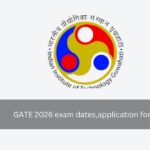UPSC ESE 2026 exam. The application process has started for the recruitment of engineers in various central government departments. The main engineering fields accepted are Civil, Mechanical, Electronics, Telecommunication and Electrical. The department includes central Indian Railway Service Engineers, Central Engineering Service, Border Roads Engineering Service (AEE civil).
GATE 2026 registration last date extended apply now
The selection process is a two-step affair, one is preliminary and another is Mains. Candidates who clear the Preliminary exam will appear for the Mains exam.

We have attached the previous year Question papers discipline wise and cut off required at the bottom of this article
Interview
The last stage is an interview stage of 200 Marks. The candidates who qualify Mains exam will reach here.
The Notification and recruitment process has started on September 26 and will be open till October 16. There are 474 vacancies available right now. The exam date has been out too it will be on February 8 2026.
Main Departments for UPSC ESE Recruits:
- Civil Engineering:
- Indian Railway Service of Engineers
- Central Engineering Service (Roads)
- Border Roads Engineering Service (AEE Civil)
- Survey of India Group A Service
- Indian Defence Service of Engineers
- Military Engineer Services (MES)
- Central Water Engineering Service
- Indian Ordnance Factories Service (Civil posts)
- Indian Railway Stores Service (Civil posts)
- Mechanical Engineering:
- Indian Railway Service of Mechanical Engineers
- Indian Railway Stores Service (Mechanical posts)
- Indian Ordnance Factories Service (Mechanical posts)
- Central Electrical and Mechanical Engineering Service
- Geological Survey of India Engineering Service
- Indian Naval Armament Service (Mechanical)
- Defence Aeronautical Quality Assurance Service (Mechanical)
- Indian Skill Development Service
- Indian Railway Management Service
- Electrical Engineering:
- Indian Defence Service of Engineers
- Central Power Engineering Service (Group A & B)
- Indian Naval Armament Service (Electrical)
- Defence Aeronautical Quality Assurance Service (Electrical)
- Indian Railway Management Service
- Electronics and Telecommunication:
- Indian Radio Regulatory Service
- Indian Telecommunication Service
- Indian Naval Armament Service (Electronics & Telecom)
- Indian Naval Material Management Service (Electronics & Telecom)
- Defence Aeronautical Quality Assurance Service (Electronics & Telecom)
- Junior Telecom Officer
- Indian Railway Management Service
Key Details for UPSC ESE 2026
- Notification Release: September 26, 2025
- Application Dates: September 26 – October 16, 2025
- Vacancies: 474
- Preliminary Exam Date: February 8, 2026
- Mains Exam Date: June 21, 2026 (tentative)
- Eligibility: Engineering degree (B.E. or B.Tech) in relevant discipline; Age 21–30 years as of January 1, 2026 (relaxations as per norms)
- Posts/Disciplines: Civil, Mechanical, Electrical, Electronics & Telecommunication in various Group A/B services like Central Engineering, Border Roads, Indian Telecommunication Service, etc.
- Selection Stages: Prelims, Mains, Personality Test
- Exam Mode: Offline (written tests)
Application & Preparation
- Applications are to be submitted online via the official portal (upsc.gov.in).
- Candidates should carefully review eligibility, syllabus, and exam pattern as given in the official notification for efficient preparation.
- Mock tests and previous years’ papers are recommended for practice.
Step-by-Step Guide to Apply Online for UPSC ESE 2026
It is advisable for the candidates while filling the application form, care should be taken to decide about choice of centre and engineering discipline for the examination.
Candidate can apply to one application form and if by chances he/she submits more than one application form in complete form. Then higher RID will be taken into account.
Higher RID is used to determine which application UPSC will process if a candidate submits more than one application for the same exam cycle.
How to apply?
- Visit Official Portal:
- Go to the UPSC online portal at www.upsconline.nic.in
- One Time URN:
- Click on the Universal Registration Number”(URN)” link.
- Register with your basic details (name, date of birth, email, mobile number, and ID card details).
- It is done once in a lifetime.
- CAF form- If you have generated your URN, then proceed to fill CAF which is next step
- Login:
- Log in using your registered credentials (email/mobile and password/OTP).
- Fill Online Application Form:
- Go to the “Active Notifications” section and click on “Indian Engineering Services (Preliminary) Examination, 2026.”
- Enter or verify personal, educational, and category details.
- Select examination center, language medium, and optional paper.
- Upload Documents:
- Upload scanned images of your passport size photograph, signature, and a valid photo ID card (Aadhaar, Voter ID, PAN, etc.).
- Photograph and signature should be in JPG format (20–300 KB, 350×350 to 1000×1000 pixels).
- Photo ID should be in PDF format (20–300 KB).
- Payment of Application Fee:
- Pay the fee online (via debit/credit card, net banking, UPI) or offline (SBI challan).
- General/OBC/EWS: Rs. 200
- Female/SC/ST/PwBD/Ex-servicemen: Nil.
- Application Preview and Submission:
- Review all details filled in the form.
- Accept the declaration and submit the form.
- After submission, download or print the confirmation page for future reference.
- Correction Window:
- After the application period closes, UPSC will provide a 7-day correction window to edit application details (except OTR details).
Advisable
- Ensure details, documents, and photo specifications meet the requirements.
- Only one application is advisable, but if multiple are submitted, the latest one (with higher registration ID) will be accepted.
- Keep your registered email/mobile active for all communications.
Common Questions
What is URN in UPSC ESE 2026?
Candidates will generate the Unique Registration Number(URN), which is a time action for all future exams.
What will happen if I have submitted more than One application for UPSC ESE 2026?
UPSC will not reject your application but it will take high RID(registration ID) into account and you can appear for the exam
Age Limits (As on 1st January 2026)
- Minimum age: 21 years
- Maximum age: 30 years (born not earlier than 2nd January 1995 and not later than 1st January 2004).
- Age relaxations:
- OBC: 3 years (up to 33 years)
- SC/ST: 5 years (up to 35 years)
- PwBD: 10 years (up to 40 years)
- Ex-servicemen, Defence personnel, ECOs/SSCOs: 5 years
- Additional relaxations as per government rules for specific categories.
Educational Qualification
- A bachelor’s degree in Engineering (B.E., B.Tech, or equivalent) from a recognized university in one of the disciplines notified (Civil, Mechanical, Electrical, Electronics & Telecommunication).
- Recognized equivalent qualifications are accepted, such as AMIE, IETE, and similar professional memberships.
- passed Sections A and B of the Institution Examinations of the Institution of Engineers (India); or
- For Indian Naval Armament Service (Electronics Engg. Posts) – M.Sc. degree or its equivalent with Wireless Communication Electronics, Radio Physics or Radio Engineering as a special subject.
- For Indian Radio Regulatory Service Group ‘A’– M.Sc. degree or its equivalent with Wireless Communication Electronics, Radio Physics or Radio Engineering as a subject or Master’s Degree in Science with Physics and Radio Communication or Electronics or Telecommunication as a special subject
- passed Associate Membership Examination Parts II and III/Sections A and B of the Aeronautical Society of India;
- Or
- passed Graduate Membership Examination of the Institution of Electronics and Radio Engineers, London held after November, 1959
Common Questions
Yes, you can apply for the UPSC ESE exam 2026 if fulfil the eligibility criteria laid down by UPSC
UPSC does not ask for any minimum marks in your engineering degree but degree should be recognized and fulfill the other eligbility criteria mentioned in the eligibility section here
Nationality
- Citizens of India, or
- Nepal/Bhutan citizens, or
- Tibetan refugees who arrived in India before 1st January 1962, or
- Persons of Indian origin migrated from specified countries and permanently settled in India.
Other Requirements
- Candidates must meet physical and medical standards as per rules in the official notification.
- No minimum percentage is required in the engineering degree for eligibility
Exam Pattern and Syllabus
The UPSC ESE 2026 exam consists of two main stages: Preliminary examination and Main examination followed by a Personality Test (Interview). The syllabus and exam pattern differ for each stage and are discipline-specific (Civil, Mechanical, Electrical, Electronics & Telecommunication). Below is a detailed overview:
UPSC ESE 2026 Exam Pattern
| Stage | Paper Name | Marks | Duration | Question Type |
| Preliminary | Paper I: General Studies & Engineering Aptitude | 200 | 2 hours | Objective MCQs |
| Paper II: Specific Engineering Discipline | 300 | 3 hours | Objective MCQs | |
| Preliminary Total | 500 | |||
| Main Exam | Paper I: Discipline-specific (Descriptive) | 300 | 3 hours | Descriptive |
| Paper II: Discipline-specific (Descriptive) | 300 | 3 hours | Descriptive | |
| Main Exam Total | 600 | |||
| Personality Test | Interview | – | – | – |
- Negative marking of 1/3rd for wrong answers in Prelims.
- Mains papers require answering 5 out of 8 long descriptive questions in each paper, testing in-depth knowledge.
UPSC ESE 2026 Syllabus
Paper I (Prelims – General Studies & Engineering Aptitude) – Common to all branches:
- Current Affairs of National and International Importance
- Engineering Mathematics (Algebra, Calculus, Vector, Statistics)
- General Principles of Design, Drawing, Importance of Safety
- Basics of Material Science, Energy, Environment
- Ethics and values, Fundamentals of Project Management
- Basics of Information and Communication Technologies
Paper II (Prelims – Discipline Specific):
Civil Engineering
- Building Materials, Solid Mechanics, Structural Analysis
- Design of Steel, Concrete and Masonry Structures
- Geotechnical Engineering, Transportation Engineering
- Environmental Engineering, Water Resources
Mechanical Engineering
- Thermodynamics, Fluid Mechanics, Heat Transfer
- Theory of Machines, Manufacturing Technology
- Machine Design, Industrial Engineering
- Materials Science, Engineering Mechanics
Electrical Engineering
- Electric Circuits, Electrical Machines
- Control Systems, Power Systems
- Analog and Digital Electronics
- Electrical Measurements & Instrumentation
Electronics & Telecommunication Engineering
- Basic Electronics, Analog & Digital Circuits
- Communication Systems, Control Systems
- Signal Processing, VLSI Technology
- Electromagnetics, Computer Architecture
UPSC ESE Mains Syllabus
- Discipline-specific advanced topics in two descriptive papers.
- Emphasis on problem-solving, design, application, and engineering principles.
- Answer 5 descriptive questions out of 8 in each paper.
Article permitted inside the Examination Hall
Battery-operated pocket calculators of “non-programmable” type only, mathematical/engineering/ drawing
instruments, including a flat rule divided on the edges into inches and tens of an inch and into centimeters
and millimeters, a slide rule, set squares, a protractor and a pair of compasses, pencils, coloured pencils,
mapping pens, eraser, T-square and drawing board for use wherever necessary. Candidates are not allowed to
bring with them any “Tables or Charts” for use in the Examination Hall.
PYQ 2025 and Cut off




